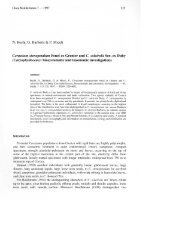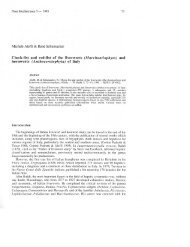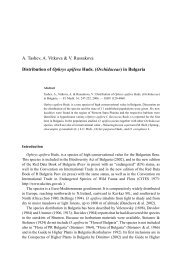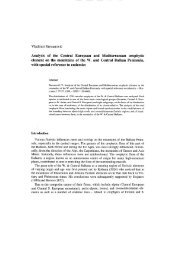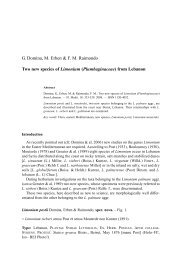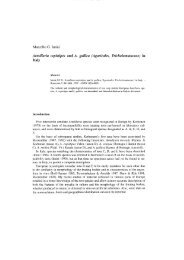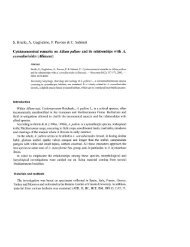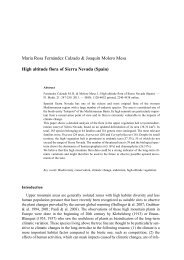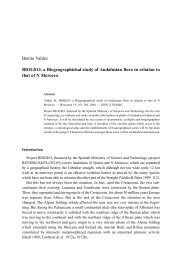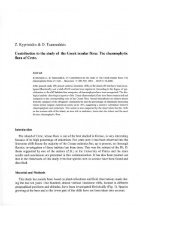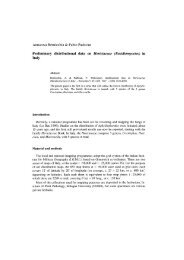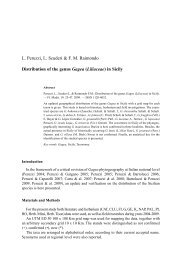Christoph Oberprieler The Systematics of Anthemis L. - Herbmedit.org
Christoph Oberprieler The Systematics of Anthemis L. - Herbmedit.org
Christoph Oberprieler The Systematics of Anthemis L. - Herbmedit.org
Create successful ePaper yourself
Turn your PDF publications into a flip-book with our unique Google optimized e-Paper software.
18 <strong>Oberprieler</strong>: <strong>Anthemis</strong> in N Africa<br />
ciation are genotype segregation in the hybrid progeny as well as backcrossing, introgression,<br />
and consequent resorption <strong>of</strong> the hybrid genotype. Grant (1981) lists seven strategies<br />
that may overcome segregation <strong>of</strong> a hybrid genome and enhance its stability. Only two<br />
such strategies, however, are connected with sexual propagation and the homoploid nature<br />
<strong>of</strong> hybrids: speciation by recombination and isolation <strong>of</strong> the hybrids from the parent species<br />
by external factors. Speciation by recombination may occur in the progeny <strong>of</strong> a sterile<br />
or semi sterile hybrid formed by hybridisation <strong>of</strong> two parent species which differ by two or<br />
more chromosomal rearrangements, when recombination types evolve that are homozygous<br />
for these rearrangements; the resulting hybrid descendants are fertile and diploid, but<br />
genetically isolated from the parent species due to a chromosomal sterility barrier. Isolation<br />
may occur when new combinations <strong>of</strong> characters lead to a mechanical, ethological, or<br />
ecological crossing barrier between descendants and their parent species. In the case <strong>of</strong><br />
A. ubensis, both possibilities exist, but evidence, which would require thorough molecular<br />
and cytological studies, is lacking.<br />
8. Delimitation <strong>of</strong> taxa - Concepts <strong>of</strong> species, subspecies, and varieties<br />
In the present revision <strong>of</strong> <strong>Anthemis</strong> in W and C North Africa the taxonomic categories<br />
<strong>of</strong> species, subspc;:cies, and variety are used to classify the encountered patterns <strong>of</strong> morphological<br />
variation at and below the species level.<br />
As noted by Jansen (1985), "much debate and little consensus exists among biologists<br />
concerning the definition <strong>of</strong> species." A number <strong>of</strong> different species concepts exist (see<br />
Rieseberg & Brouillet 1994: 24 for a comprehensive list), based on biological (e.g. the<br />
biological, better termed reproductive, species concept <strong>of</strong> Mayr 1969, 1970), phenetic<br />
(Cronquist 1988), ecological (Van Valen 1976), and phyIogenetic criteria (the phylogenetic<br />
species concept <strong>of</strong> Cracraft 1989 and the autapomorphic species concept <strong>of</strong> Mishler<br />
& Brandon 1987).<br />
A primarily morphoIogical or phenetic species concept has been used in the present<br />
study. As discussed in the previous chapter, morphological discontinuities are assumed to<br />
be due to genetic differences and, together with cytoiogical and molecular information in<br />
some taxa groups, to a certain degree are taken to reflect speciation processes and phylogenetic<br />
relationships. Since patterns <strong>of</strong> morphological variation show marked differences<br />
between different subgroups <strong>of</strong> the genus, the resulting species may not be equivalent. As<br />
noted by Lewis (1955, cited in Stuessy 1990:179), "the pattern <strong>of</strong>morphological differentiation<br />
may differ from one group <strong>of</strong> pIants to another and is a reflection <strong>of</strong> the diversity <strong>of</strong><br />
evolutionary processes. Consequently, species and subspecies are not necessariIy equivalent<br />
in different genera or different sections <strong>of</strong> the same genus." As discussed above, the<br />
prevailing modes <strong>of</strong> speciation in perenniaIs <strong>of</strong> <strong>Anthemis</strong> sect. Hiorthia are hybridisation<br />
and polypIoidy, while in annuals <strong>of</strong> A. sect. <strong>Anthemis</strong> allopatric speciation and Iocal<br />
(founder effect) speciation (Levin 1993) is usually encountered. <strong>The</strong>refore, species acknowledged<br />
in the former section tend to be wide-spread, poIymorphic, and <strong>of</strong>ten exhibit<br />
clinal variation <strong>of</strong> morphoIogical characters; while those <strong>of</strong> the latter section tend to be<br />
more local and Iess poIymorphic.



